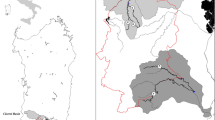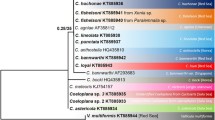Abstract
Two morphotypes of Plectropomus leopardus have been identified; morphometric and meristic analyses show that there is no diagnostic difference between them. A difference in color pattern was the most appropriate phenotypic character with which to distinguish between the two morphotypes. Complete mitochondrialDNA sequencing, however, indicated a clear difference between the two morphotypes. Barcoding analysis revealed no significant difference (P>0.05) in CO1 or ND2 divergence among intramorphotypic individuals, even between geographically separated populations, whereas the intermorphotypic CO1 and ND2 divergences were large enough (averaging 0.95% for CO1 and 1.37% for ND2) to clearly discriminate between the two morphotypes. The color pattern difference, geographical distribution, together with the mtDNA and barcode sequencing data, suggest that the two morphotypes should be of two subspecies or even two species.
Similar content being viewed by others
References
Ashley J F, Jean-Paul A H. 2007. In vitro hybridization of coral trouts, Plectropomus leopardus (Lacepède, 1802) and Plectropomus maculatus (Bloch, 1790): a preliminary investigation. Aquaculture Research, 38: 215–218
Avise J C, Wollenberg K. 1997. Phylogenetics and the origin of species. Proceedings of the National Academy of Sciences, USA, 94: 7748–7755
Baldwin Z H, Sparks J S. 2011. A new species of Secutor (Teleostei: Leiognathidae) from the Western Indian Ocean. Zootaxa, 2998: 39–47
Boore J L, Daehler L L, Brown W M. 1999. Complete sequence, gene arrangement, and genetic code of mitochondrial DNA of the Cephalochordate Branchiostoma floridae (Amphioxus). Molecular Biology Evolution, 16: 410–418
Brown W M. 1985. The mitochondrial genome of animals. In: Molecular Evolutionary Genetics. New York: Plenum Press, 95–130
Chen Lochai. 1985. A study of the Sebastes inermis species complex with delimitation of the subgenus Mebarus (Pisces, Scorpaenidae). Journal of TaiwanMuseum, 38: 23–37
Crandall E D, Frey M A, Grossberg R K, et al. 2008. Contrasting demographic history and phylogeographical patterns in two Indo-Pacific gastropods. Molecular Ecology, 17: 611–626
DeAstarloa J MD, Mabragana E, Hanner R, et al. 2008. Morphological andmolecular evidence for a new species of longnose skate (Rajiformes: Rajidae: Dipturus) from Argentinean waters. Zootaxa, 1921: 35–46
de Queiroz K. 1998. The general lineage concept of species, species criteria, and the process of speciation. In: Endless Forms: Species and Speciation. New York: Oxford University Press, 57–71
Ding Shaoxiong, Zhuang Xuan, Guo Feng, et al. 2006. Molecular phylogenetic relationships of China Seas groupers based on cytochrome b gene fragment sequences. Science in China Series C (Life Sciences), 49: 235–242
Graig M, Sadovy Y, Heemstra P. 2011. Groupers of the World: A Field andMarket Guide. Grahamstown, South Africa: NISC (Pty) Ltd
Greenfield D W, Randall J E. 2011. Two new Indo-Pacific species in the Eviota nigriventris complex (Teleostei: Gobiidae). Zootaxa, 2997: 54–66
Heemstra P C, Randall J E. 1993. Groupers of the World. In: Heemstra P C, Randall J E, eds. FAO Species Catalogue. vol 16. Rome: Food and Agriculture Organization of the United Nations
Kai Y, Nakabo T. 2002. Morphological differences among three color morphotypes of Sebastes inermis (Scorpaenidae). Ichythyological Research, 49: 260–266
Kai Y, Sato T, Nakae M, et al. 2004. Genetic divergence between and within two color morphotypes of Parapercis sexfasciata (Perciformes: Pinguipedidae) from Tosa Bay, southern Japan. Ichythyological Research, 51: 381–385
Knittweis L, Kraemer W E, Timm J, et al. 2009. Genetic structure of Heliofungia actiniformis (Scleractinia: Fungiidae) populations in the Indo-Malay Archipelago: implications for live coral trade management eforts. Conservation Genetics, 10: 241–249
Koichiro T, Masatoshi N. 1993. Estimation of the number of nucleotide substitutions in the control region of mitochondrial DNA in humans and chimpanzees. Molecular Biology Evolution, 10: 512–526
Kumar S, Tamura K, Jakobsen I B, et al. 2001. MEGA2, molecular evolutionary genetics analysis software. Bioinformatics, 17: 1244–1245
Leis J M. 1986. Larval development in four species of Indo-Pacific coral trout Plectropomus (Pisces: Serranidae: Epinephelinae) with an analysis of the relationships of the genus. Bulletin of Marine Science, 38(3): 525–552
Liao Yunchih, Cheng Tunyuan, Shao Kwangtshao. 2011. Parapercis lutevittata, a new cryptic species of Parapercis (Teleostei: Pinguipedidae), from the western Pacific based on morphological evidence and DNA barcoding. Zootaxa, 2867: 32–42
Lin G, Lo L C, Zhu Z Y, et al. 2006. The Complete Mitochondrial Genome Sequence and Characterization of Single-Nucleotide Polymorphisms in the Control Region of the Asian Seabass (Lates calcarifer). Marine Biotechnology, 8: 71–79
Mayr E. 1963. Animal Species and Evolution. Cambridge, Massachusetts: Belknap Press
Mehrdad H, Daniel H J, John M B, et al. 2005. DNA barcodes distinguish species of tropical Lepidoptera. Proceedings of the National Academy of Sciences, USA, 103: 968–971
Mink D G, Sites J W Jr. 1996. Species limits, phylogenetic relationships, and origins of viviparity in the Scalaris complex of the lizard genus Sceloporus (Phrynosomatidae). Herpetologica, 52: 551–557
Paul D N H, Alina C, Shelley L B, et al. 2003. Biological identifications through DNA barcodes. Proceedings of the Royal Society of London, Series B: Biological Sciences, 270: 313–321
Paul D N H, Sujeevan R, Jeremy R D. 2003. Barcoding animal life: cytochrome c oxidase subunit 1 divergences among closely related species. Proceedings of the Royal Society of London, Series B: Biological Sciences, 270: S96–S99
Pyle R, Earle J L, Greene B D. 2008. Five new species of the damselfish genus Chromis (Perciformes: Labroidei: Pomacentradae) from deep coral reefs in the tropical western Pacific. Zootaxa, 1671: 3–31
Randall J E, Hoese D F. 1986. Revision of the groupers of the Indo-Pacific genus Plectropomus (Perciformes: Serranidae). Indo-Pacific Fishes, 13: 1–31
Robert D W, Tyler S Z, Bronwyn H I, et al. 2005. DNA barcoding Australia’s fish species. Philosophical Transactions of the Royal Society of London, Series B: Biological Sciences, 360: 1847–1857
Sambrook J, Russell DW. 2001. Molecular Cloning: A Laboratory Manual. 3nd ed. New York: Cold Spring Harbor Laboratory Press
Smith MA. 2008. Using DNA barcodes to assess identity and diversity of Dendropsophusminutus: Failure?. Zootaxa, 1691: 67–68
Smith P J, Steinke D, McMillan P J, et al. 2011. DNA barcoding highlights a cryptic species of grenadier Macrourus in the Southern Ocean. Journal of Fish Biology, 78: 355–365
Thomas J P, David S M, Kevin S, et al. 1997. A high observed substitution rate in the human mitochondrial DNA control region. Nature genetics, 15: 363–368
Thompson J D, Gibson T J, Plewniak F, et al. 1997. The CLUSTAL_X windows interface: flexible strategies for multiple sequence alignment aided by quality analysis tools. Nucleic Acids Research, 25: 4876–4882
Tsoi K H, Wang Z Y, Chu K H. 2005. Genetic divergence between two morphologically similar varieties of the kuruma shrimp Penaeus japonicus. Marine Biology, 147: 367–379
van Herwerden Lynne, Choat J Howard, Newman Stephen J, et al. 2009. Complex patterns of population structure and recruitment of Plectropomus leopardus (Pisces: Epinephelidae) in the Indo-West PaciWc: implications for Wsheries management. Marine Biology, 156: 1595–1607
Vincent M, Catherine H, Alessandro A, et al. 2005. Single, rapid coastal settlement of Asia revealed by analysis of complete mitochondrial genomes. Science, 308: 1034–1036
Xing Yingchun, Zhao Yahui, Tang Wenqiang, et al. 2011. A new species, Microphysogobio wulonghensis (Teleostei: Cypriniformes: Cyprinidae), from Shandong Province, China. Zootaxa, (2901): 59–68
Zhu Zeyuan, Yue Genhua. 2008. The complete mitochondrial genome of red grouper Plectropomus leopardus and its applications in identification of grouper species. Aquaculture, 276: 44–49
Zhuang Xuan, Ding Shaoxiong, Wang Jun, et al. 2009. A set of 16 consensus primer pairs amplifying the completemitochondrial genomes of orange-spotted grouper (Epinephelus coioides) and- Hong Kong grouper (Epinephelus akaara). Molecular Ecology Resources, 9(6): 1551–1553
Author information
Authors and Affiliations
Corresponding author
Additional information
Foundation item: Key Programof the Science and Technology Department Foundation of Fujian Province under contract No. 2007N0050; the Seed Industry Innovation and Industrialization Project of Fujian Province, China (on the subtopic of groupers).
Rights and permissions
About this article
Cite this article
Cai, X., Qu, M., Ding, S. et al. Differentiation of coral trout (Plectropomus leopardus) based on an analysis of morphology and complete mitochondrial DNA: Are cryptic species present?. Acta Oceanol. Sin. 32, 40–46 (2013). https://doi.org/10.1007/s13131-013-0304-6
Received:
Accepted:
Published:
Issue Date:
DOI: https://doi.org/10.1007/s13131-013-0304-6




